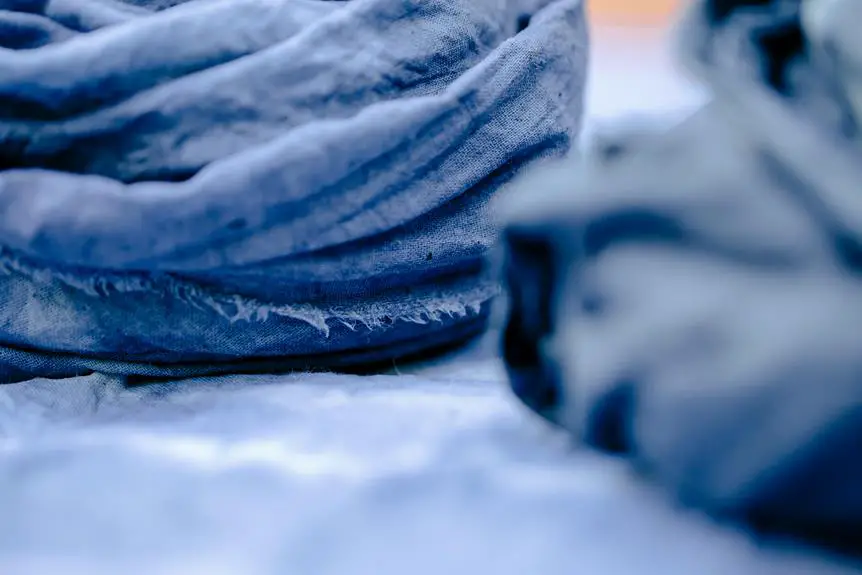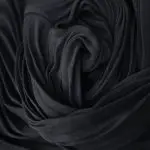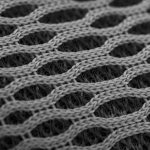If you're looking to refresh your chambray fabric with a new color, understanding the dyeing process is essential. You'll want to choose the right dye—fiber-reactive dyes are often the best option for vibrant results. Before you start, you'll need to prepare your fabric properly and gather the necessary tools to ensure success. By following a few straightforward steps, you can achieve a professional-looking finish. But what happens if you skip an important step? That could mean the difference between a successful dye job and a disappointing outcome.
Table of Contents
Key Takeaways
- Choose a fiber-reactive dye for vibrant colors, and consider chambray's blue hue before dyeing for accurate color expectations.
- Pre-wash chambray fabric to remove oils, then soak in a salt or vinegar solution for better dye adherence.
- Use a large container for dyeing, and wear protective gear to prevent stains and fumes exposure.
- Rinse dyed fabric in cold water until runoff is clear, then wash with mild detergent and air dry away from sunlight.
Choosing the Right Dye
When choosing the right dye for chambray fabric, consider the fabric's composition and the desired color outcome. Chambray is usually made of cotton, so using a fiber-reactive dye, like Procion MX, is your best bet. This type of dye bonds chemically with the fibers, ensuring vibrant and long-lasting results.
If you're aiming for a more muted tone or want to experiment, you might try an all-purpose dye like Rit, but keep in mind that it may not be as colorfast.
Next, think about the color you want to achieve. If you're going for a bold look, deeper shades like navy or crimson will stand out beautifully against chambray's natural texture. Alternatively, lighter hues can give a softer, vintage feel. Always test your dye on a small fabric swatch first to see how it interacts with the material and to confirm it meets your expectations.
Lastly, if you're dyeing a garment, remember that seams and hems might absorb dye differently. Plan for that variation and keep your final color in mind as you make your choices. The right dye can elevate your project, so take your time in selecting it!
Preparing Your Chambray Fabric
Properly preparing your chambray fabric ensures the dye adheres evenly and produces vibrant results. Start by washing the fabric to remove any dirt, oils, or finishes that could hinder dye absorption. Use a mild detergent and avoid fabric softeners, as they can leave a residue on the fabric.
Once washed, rinse the chambray thoroughly in cold water to eliminate any soap residue. After rinsing, gently squeeze out excess water without wringing, as this can distort the fabric.
Next, you'll want to pre-soak the chambray in a solution of water and salt or vinegar, depending on your dye type. This step helps set the dye, ensuring a more uniform color. After soaking for about 30 minutes, remove the fabric and let it drip dry for a moment.
You can then lay it flat on a clean surface to ensure it's wrinkle-free before dyeing. If you're working with multiple pieces, make sure they're cut to the same size and shape for consistent results.
With your chambray fabric properly prepared, you're ready to dive into the dyeing process and enjoy the transformation!
Essential Dyeing Tools
To achieve the best results in dyeing chambray fabric, you'll need a few key tools to make the process smoother and more effective.
Having the right items on hand not only streamlines your workflow but also ensures that your fabric takes on the dye beautifully.
Here's a list of essential dyeing tools you should gather before you start:
- Dye: Choose a high-quality fabric dye suitable for cotton blends, as chambray is typically made of cotton and polyester.
- Large Container: A bucket or basin is necessary for mixing the dye and submerging your fabric. Make sure it's big enough to hold the fabric without crowding.
Having these tools ready will set the stage for a successful dyeing experience.
With everything in place, you'll be well-prepared to transform your chambray fabric into a vibrant piece that reflects your personal style.
Happy dyeing!
Step-by-Step Dyeing Process
To start your dyeing journey, you'll need to prepare the fabric properly, which sets the stage for successful results.
Next, you'll choose the right dye that suits your vision, followed by exploring various dyeing techniques to achieve the desired effect.
Let's break down each step to ensure you get the best outcome for your chambray fabric.
Preparing the Fabric
Start by washing the chambray fabric to remove any dirt, oils, or finishes that could interfere with the dye absorption. This initial step is crucial for ensuring that your fabric takes the dye evenly and vibrantly. Use warm water and a mild detergent, then rinse thoroughly. After washing, avoid using fabric softeners, as they can leave residues that hinder dye penetration.
Next, you'll want to dry the fabric. You can either air dry it or tumble dry on low, but make sure it's completely dry before proceeding. If you're planning to dye multiple pieces, consider pre-washing all of them together to maintain a consistent color.
Keep these tips in mind as you prepare your fabric:
- Use distilled water if your tap water contains minerals that could affect the dye.
- Iron the fabric before dyeing to remove wrinkles, which can create uneven dyeing.
Following these steps will set you up for successful dyeing results!
Choosing the Dye
Choosing the right dye is essential, as it determines the final color and vibrancy of your chambray fabric. You've got a variety of options, including fiber-reactive dyes, all-purpose dyes, and natural dyes. Each type has its unique properties, so understanding these will help you make an informed choice.
Here's a quick comparison of different dye types:
| Dye Type | Best For | Color Fastness |
|---|---|---|
| Fiber-Reactive Dye | Cotton and blends | Excellent |
| All-Purpose Dye | Multiple fabrics | Good, but may fade |
| Natural Dye | Eco-friendly projects | Variable, depends on the mordant used |
When selecting a dye, consider the fabric content of your chambray. If it's primarily cotton, fiber-reactive dyes are your best bet for vibrant and long-lasting results. For mixed fabrics, all-purpose dyes work well, but be prepared for some fading over time. If you prefer an eco-friendly approach, natural dyes can provide beautiful colors, though they require more preparation. Make sure to choose the dye that aligns with your project goals!
Dyeing Techniques Explained
Dyeing chambray fabric involves a series of straightforward steps that ensure your fabric absorbs color evenly and vibrantly.
First, you'll want to pre-wash the chambray to remove any finishes that might prevent the dye from setting properly. Once clean, prepare your dye solution according to the manufacturer's instructions, ensuring you have enough water to fully submerge the fabric.
Next, immerse the chambray in the dye bath, stirring gently to promote even color distribution. Keep an eye on the fabric as it soaks, checking for the desired shade. Once achieved, remove the fabric and rinse it in cold water until the runoff is clear. After rinsing, wash it again with a mild detergent to remove any excess dye. Finally, hang or lay it flat to dry away from direct sunlight.
Here are a few tips to keep in mind:
- Always wear gloves to protect your hands from dye.
- Test the dye on a small fabric sample first.
Following these steps will help you achieve beautiful, vibrant results!
Setting the Dye
Once you've dyed your chambray fabric, it's crucial to set the dye properly to ensure vibrant, lasting color.
You'll need to prepare the fabric correctly, choose the right dye, and take steps to fix the color effectively.
Let's explore these essential points to help you achieve the best results.
Preparing Fabric Properly
To set the dye effectively, start by washing your chambray fabric in hot water to remove any finishes that might hinder dye absorption. This initial step is crucial for achieving vibrant, long-lasting color.
After washing, don't forget to rinse the fabric thoroughly to eliminate any detergent residue. This ensures that the dye can penetrate evenly and consistently.
Next, you'll want to soak the fabric in a solution that prepares it for dyeing. Using a fixative like salt or vinegar can enhance the dye's adherence, depending on the type you're using. Make sure to follow the instructions for the fixative to achieve the best results.
Before diving into the dyeing process, keep these tips in mind:
- Test a small swatch: This helps you gauge how the fabric will absorb color.
- Ensure the fabric is damp: A slightly damp fabric can absorb dye more effectively than a dry one.
Choosing the Right Dye
Selecting the right dye for your chambray fabric is essential for achieving the desired color and ensuring it sets properly.
You'll want to choose a dye specifically formulated for cotton or cotton blends, as chambray is typically made from these materials. Fiber reactive dyes are a fantastic option because they bond with the fabric, resulting in vibrant and long-lasting colors.
When picking a dye, consider the color you want to achieve. Keep in mind that chambray fabric often has a subtle blue hue, which might affect the final result. It's wise to test the dye on a small swatch first; this will help you see how the color interacts with the fabric.
Additionally, think about the dyeing method you plan to use. Some dyes work better in a washing machine, while others are ideal for stovetop or immersion dyeing. Always read the manufacturer's instructions carefully to ensure you're using the dye correctly and at the right temperature.
Lastly, don't forget to gather all necessary materials, like gloves and stirring tools, to make your dyeing process smooth and successful.
Fixing the Color
Setting the dye properly is crucial to ensure your chambray fabric retains its vibrant color after dyeing. If you skip this step, you risk washing away all your hard work. Here are a few steps to effectively set the dye and keep your fabric looking fresh:
- Use a Fixative: Apply a commercial dye fixative or a solution of vinegar and water to help lock in the color. Follow the manufacturer's instructions for the best results.
- Heat Treatment: Iron your fabric on a medium setting after it's dried. The heat helps to bond the dye to the fibers, enhancing color retention.
Caring for Dyed Chambray
How can you ensure your dyed chambray stays vibrant and lasts longer? Start by washing it properly. Use cold water and a gentle detergent to prevent fading. Avoid bleach, as it can strip the color and damage the fabric. When washing, turn your chambray inside out to minimize friction and protect the dye.
After washing, air-dry your chambray instead of using a dryer. Direct heat can cause colors to fade and weaken the fibers. If you must use a dryer, choose a low heat setting, but keep in mind that air-drying is always better for maintaining vibrancy.
When it comes to ironing, use a low heat setting as well. High temperatures can scorch the dye, so always check the fabric care label for specific instructions. If you notice any fading over time, consider re-dyeing the fabric to refresh its color.
Lastly, store your dyed chambray in a cool, dry place away from direct sunlight. Sunlight can cause colors to fade, so consider using protective garment bags if you're storing it for an extended period.
Frequently Asked Questions
Can I Dye Chambray Fabric Multiple Colors at Once?
You can dye chambray fabric multiple colors at once, but you'll need to plan carefully. Using techniques like tie-dye or ombre effects can help you achieve a beautiful, multi-colored result that looks stunning.
What Types of Dye Work Best for Chambray?
For chambray, fiber-reactive dyes work best since they bond well with cotton. You'll get vibrant colors and excellent wash durability. Avoid using all-purpose dyes, as they might not yield the desired results for this fabric.
Is It Safe to Dye Chambray Indoors?
Yes, it's generally safe to dye chambray indoors, but ensure proper ventilation. Use protective gear, like gloves and masks, to avoid skin irritation and inhalation of fumes. Always follow dye instructions carefully for best results.
How Do I Remove Dye Stains From My Skin?
To remove dye stains from your skin, wash the area with soap and warm water. If that doesn't work, try rubbing alcohol or baby oil, then rinse thoroughly. Always test on a small skin area first.
Can I Dye Chambray Fabric That Has Been Previously Washed?
Yes, you can dye chambray fabric that's been washed. Just ensure it's clean and free from any residues. Pre-soaking in water helps the dye absorb better, giving you a vibrant and even color.
- How Does Ring Spun Cotton Affect Garment Fit and Shape Retention? - August 13, 2024
- What Are the Challenges in Producing Ring Spun Cotton? - August 13, 2024
- Is Ring Spun Cotton Suitable for Plus-Size Clothing? - August 13, 2024







